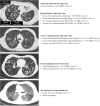The value of high-resolution computed tomography (HRCT) to determine exercise ventilatory inefficiency and dynamic hyperinflation in adult patients with cystic fibrosis
- PMID: 31014329
- PMCID: PMC6480643
- DOI: 10.1186/s12931-019-1044-8
The value of high-resolution computed tomography (HRCT) to determine exercise ventilatory inefficiency and dynamic hyperinflation in adult patients with cystic fibrosis
Abstract
Introduction: In Cystic Fibrosis (CF), exercise ventilatory inefficiency and dynamic hyperinflation (DH) cause exercise limitation and induce poor exercise tolerance. High-resolution computed tomography (HRCT) of the lung can detect pulmonary abnormalities in CF patients. We aimed to identify the determinants of exercise ventilatory inefficiency and DH using HRCT-derived metrics.
Methods: Fifty-two adult CF patients were prospectively enrolled; all participants underwent cardio-pulmonary exercise test (CPET) and HRCT. Radiological impairment was evaluated by the Brody II scoring system. Slope and intercept of the minute ventilation/CO2 production (V'E/V'CO2) regression line and the ratio of inspiratory capacity/total lung capacity (IC/TLC) at rest and at peak of exercise were measured.
Results: Four groups of patients were identified based on the combination of ventilatory efficiency (Vef) or inefficiency (Vin) and the presence/absence of DH. Compared to other groups, CF adults with Vin and DH had worse functional status and higher total (T), bronchiectasis (B) and air trapping (AT) scores at HRCT. Significant correlations were found between V'E/V'CO2 intercept and V'E/V'CO2 slope (ρ - 0.455, p = 0.001) and between V'E/V'CO2 intercept and Δ inspiratory capacity (IC) (ρ - 0.334, p = 0.015). Regression analysis identified AT score (cut-off 7.9, odds ratio-OR 3.50) as the only independent predictor of Vin and T (cut-off 53.6, OR 4.98), B (cut-off 16.1, OR 4.88), airways wall thickening (AWT) (cut-off 13, OR 3.41), and mucous plugging (MP) scores (cut-off 11.7, OR 4.18) as significant predictors of DH.
Conclusion: In adult CF cohort, values of HRCT metrics are determinants of Vin (AT) and DH (T, B, AWT, MP).
Keywords: Brody II score; Cystic fibrosis; Dynamic hyperinflation; Ventilatory inefficiency.
Conflict of interest statement
Ethics approval and consent to participate
The ethical committee of the University Hospital of Parma approved the protocol (approval number: 200084; 07 June 2013).
Consent for publication
Not applicable.
Competing interests
The authors declare that they have no competing interests
Publisher’s Note
Springer Nature remains neutral with regard to jurisdictional claims in published maps and institutional affiliations.
Figures





Similar articles
-
Exercise ventilatory efficiency in elite athletes assessed for the Paris 2024 Olympic Games: The effect of sex and sport categories.Physiol Rep. 2025 Apr;13(7):e70261. doi: 10.14814/phy2.70261. Physiol Rep. 2025. PMID: 40176468 Free PMC article.
-
Relationships between emphysema and airways metrics at High-Resolution Computed Tomography (HRCT) and ventilatory response to exercise in mild to moderate COPD patients.Respir Med. 2016 Aug;117:207-14. doi: 10.1016/j.rmed.2016.06.016. Epub 2016 Jun 21. Respir Med. 2016. PMID: 27492533
-
Minute ventilation to carbon dioxide output (V'E/V'CO2 slope) is the strongest death predictor before larger lung resections.Monaldi Arch Chest Dis. 2017 Sep 22;87(3):817. doi: 10.4081/monaldi.2017.817. Monaldi Arch Chest Dis. 2017. PMID: 29424191
-
Physiological and clinical relevance of exercise ventilatory efficiency in COPD.Eur Respir J. 2017 Mar 8;49(3):1602036. doi: 10.1183/13993003.02036-2016. Print 2017 Mar. Eur Respir J. 2017. PMID: 28275174 Review.
-
Ventilatory response to exercise in cardiopulmonary disease: the role of chemosensitivity and dead space.Eur Respir J. 2018 Feb 7;51(2):1700860. doi: 10.1183/13993003.00860-2017. Print 2018 Feb. Eur Respir J. 2018. PMID: 29437936 Review.
Cited by
-
Identification of Subclinical Lung Involvement in ACPA-Positive Subjects through Functional Assessment and Serum Biomarkers.Int J Mol Sci. 2020 Jul 21;21(14):5162. doi: 10.3390/ijms21145162. Int J Mol Sci. 2020. PMID: 32708286 Free PMC article.
-
Decreased ventilatory efficiency during incremental exercise in bronchiectasis.J Thorac Dis. 2020 May;12(5):2717-2723. doi: 10.21037/jtd.2020.03.113. J Thorac Dis. 2020. PMID: 32642180 Free PMC article. No abstract available.
-
Exercise and Cystic Fibrosis.Adv Exp Med Biol. 2020;1228:381-391. doi: 10.1007/978-981-15-1792-1_26. Adv Exp Med Biol. 2020. PMID: 32342472 Review.
-
Detection of Small Airway Dysfunction in Asymptomatic Smokers with Preserved Spirometry: The Value of the Impulse Oscillometry System.Int J Chron Obstruct Pulmon Dis. 2021 Sep 14;16:2585-2590. doi: 10.2147/COPD.S319972. eCollection 2021. Int J Chron Obstruct Pulmon Dis. 2021. PMID: 34548789 Free PMC article.
-
Association of air pollution exposure with exercise-induced oxygen desaturation in COPD.Respir Res. 2022 Mar 31;23(1):77. doi: 10.1186/s12931-022-02000-1. Respir Res. 2022. PMID: 35361214 Free PMC article.

